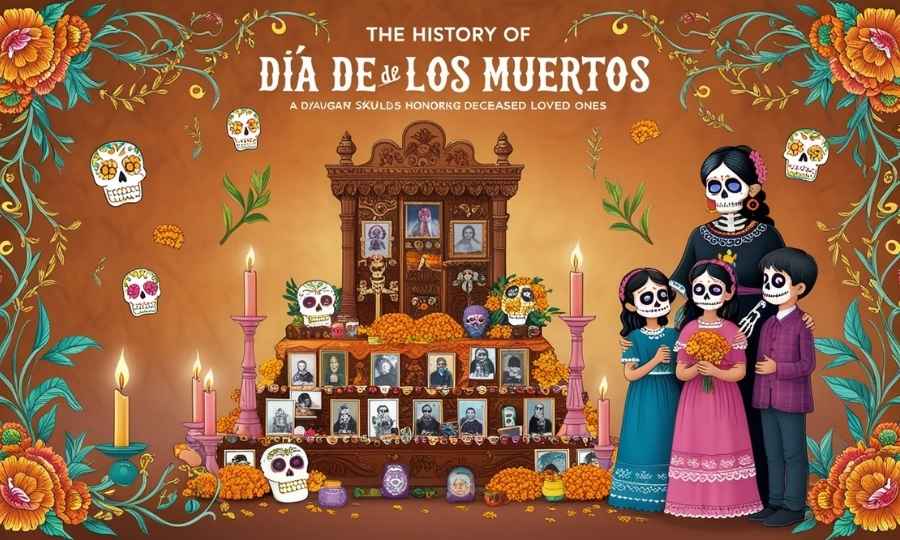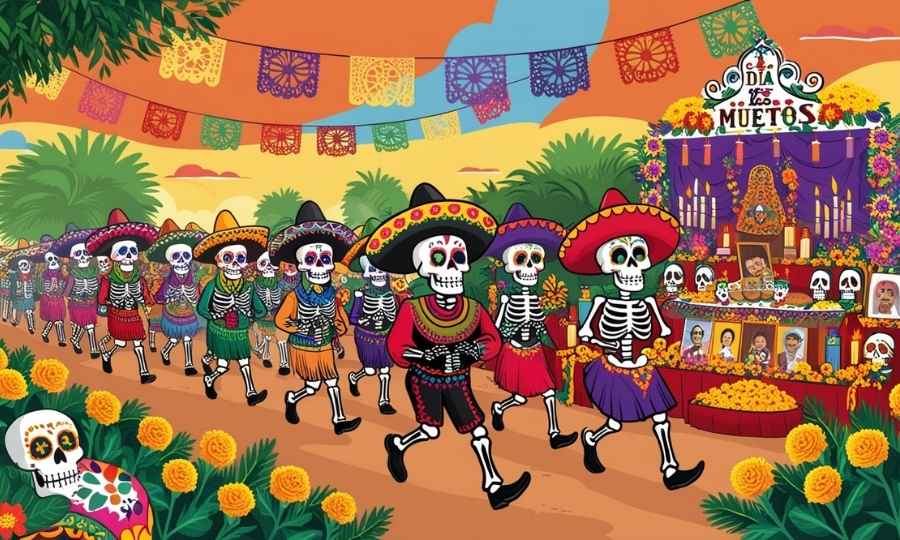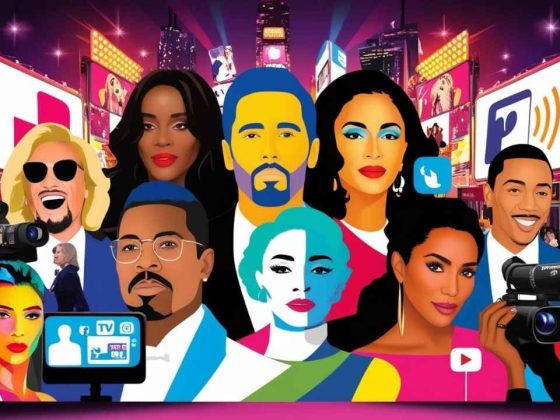Día de los Muertos, which translates as Day of the Dead, is a colourful and significant festival, mainly practised in Mexico and among Mexican-Americans living in the US. It takes place on the first and second of November, with much regard given to the dead.
Different from Halloween’s ideas of horror and the frightening aspects of life, El Día de los Muertos is a positive event that celebrates life along with death since this is just a phase in human life. Even UNESCO lists this event as an Intangible Cultural Heritage of Humanity, which explains its distinctive customs and historical importance.
Key Takeaways
- Originating from the Mexican culture and based on Aztec traditions, Día de los Muertos is a cheerful celebration that combines both dead and living.
- The occasion integrates native traditions with those of the Catholic Church to provide an effective means in which to remember loved ones who have passed away.
- Marigolds, sugar skulls, and ofrendas are used as symbols as they are crucial in the introducing and directing the spirits.
- Other societies across the globe have their practices and traditions for the dead which is very much similar to each other.
- Día de los Muertos is an occasion that can be enjoyed by the entire family with special recognition by UNESCO for the celebration of life and continuity of lineage.
What is Día de los Muertos?
Day of the dead is not just one more mourning, it is a party in honor of life and the endless cycle of the soul. It is a tradition that dates back to the ancient Mesoamerican customs, especially that of the Aztecs and other Nahua peoples, who considered that death was a more part of existence, a cyclical part.
With the arrival of the Spaniards, the holiday incorporated elements of Christianity, such as All Saints Day and the day of all the deceased faithful. The result is explained by the coexistence of native and European traditions that at the same time celebrate and cry life through food, music, art and family gatherings.
Origins and History of Día de los Muertos
Ancient Aztec Roots
The celebration of the Day of the Dead has its ancestors of thousands of years ago when the Aztecs celebrated for a whole month life and death in the company of their loved ones already deceased. Death was not the end, but part of the cycle that gave way to life in the cyclical vision that the Mexica had.
The dead never went out. They resided in Mictlán, the underworld, waiting for an opportunity to return to the world of the living on special dates, such as the Day of the Dead.
Catholic Influence
With Spanish colonization in Mexico, Catholic traditions such as All Saints Day and all the dead, which are remembered on November 1 and 2, also arrived. The fusion of religions towards Christianity and the religion of the natives towards death gave rise to the Day of the Dead.
Thanks to this mixture of cultures, the day of the dead has become a celebration in which the living and the dead are remembered through various acts, prayers and parties.
How do Different Cultures Honor the Dead?
Various cultures from different parts of the world have their own special practices for remembering the dead. In Japan for instance, during the Obon Festival, people invite the spirits of their ancestors back to the world of the living, much like during Día de los Muertos.
Likewise, in Korea, during Chuseok, which is a harvest festival, families pay homage to their ancestors. Such family members are also remembered and respected in countries like the Philippines, Ghana, Madagascar, and many others where elaborate ceremonies are performed, depicting that this is a universal theme among humans only that it is expressed in different ways.
Key Dates of Día de los Muertos
November 1st – Día de los Angelitos
The observances take off on the 1st of November which is popularly known as the Day of the Little Angels – Día de los Angelitos. This day is set apart in memory of the children who died. The family members build ofrendas for these children’s spirits with toys, candies and small sugar skulls and which are meant to attract these souls back for the day.
November 2nd – Día de los Muertos
The most significant commemoration takes place on the second of November which is the day set apart for the dead, specifically to remember the adult dead. A number of families go to the cemeteries and clean as well as beautify the tombs, and they have also to create expensive ofrendas including dishes, drinks, and belongings of the deceased.
On this day extends both moments of quiet and the moments of family happiness, when families gather to remember their deceased.
What are the Traditions of Death in Mexico?
Death in Mexico tends to be accepted as the next stage in the cycle of life. Death which is part of the human existence goes beyond just the day of the dead for Mexicans. Funerals are important events and many people go to the gravesites of the deceased quite often, maintaining these persons in their memories by telling stories, cooking their favorite dishes, and placing flowers and candles at their gravesites.
Symbols of Día de los Muertos
The Altar (Ofrenda)
The ofrenda is the main element in D?a de los Muertos. It is set out so that the spirits can come back and rests on flowers, photos and other items that the loved ones used to have.
Everything in the ofrenda serves a function; for instance, marigolds are used to bring back the spirits of the dead to the world of the living while incense is used to cleanse the area and lead the spirits to their resting places.
Skulls and Skeletons (Calaveras and La Catrina)
Calaveras, or skulls, are perhaps the most famous symbols associated with the Day of the Dead. These skulls are often made of sugar, colored in various hues, and are placed on family altars or used as ornaments.
La Catrina is another important figure in the region– an elegantly dressed skeleton whom many people associate with the holiday. Created by artist José Guadalupe Posada, La Catrina reminds us that death awaits all since it is a great equalizer of humanity.
Marigolds (Flor de Muerto)
The marigold flower which is sometimes referred to as flor de muerto is believed to help the dead in finding their way. The flowers help make decorative lines that run from a grave up to the oferenda. The flowers are said to have special scent and beautiful color which are strong and friendly to welcome them back to the family’s arms.
Pan de Muerto (Bread of the Dead)
Pan de Muerto is the bread of the dead, and it is rich and sticky bread baked on the day of the dead, worn as cranium shapes covered in sugar. The bread is varied with bones and the offering is placed on the ofrenda for the spirits. It also stand for the cycle of life and death, and the bread is round to show that life continues.
What are 5 Facts about the Day of the Dead?
- Día de los Muertos is a fusion of native customs and Roman Catholic beliefs.
- Marigolds, or flowers of the dead are also called flor de muerto which assist spirits to retrace their steps home.
- Sugar skulls signify those who are dead and tend to have the deceased’s name written on them.
- This feast is listed in the UNESCO Registry of Intangible Cultural Heritage of Humanity.
- La Catrina, which is a skeleton dressed in exquisite clothing, becomes the most remarkable emblem of Día de los Muertos.
How do you Celebrate the Day of the Dead?
Easiest way to pay tribute to the departed is by creating an ofrenda (also a ofrenda, or altar) where images, food and items belonging to those who have passed away are placed, and this will be accompanied by pictures or even sculptures of them.
You can also just paint your face as a Calavera, head to the streets with many others and celebrate or even go out to a gravesite and, with many others out there, remember those you’ve lost.
How Día de los Muertos is Celebrated
Face Painting and Costumes
It has become a tradition for people to face paint skulls among other patterns during the celebration of the Día de los Muertos. Within their culture, many paint themselves to resemble calaveras – with intricate designs and bright colors. This is said to express how the living engage with the dead as well as highlight the beauty associated with life and death.
Parades and Public Festivities
A number of well – known parades are conducted in various towns and cities across Mexico, Mexico City being one of the most famous. This parade is filled with beautiful costumes, floats and music making the community collectively honor their culture which unites them all.
Cemetery Gatherings
As November 2nd nears, you will discover a fair number of families heading towards cemeteries in appreciation of the deceased folk in their families. The cleaning and decorating of graves take place over the lighting of candles and at times the entire night is dedicated for such festivities.
Such a custom permits a bereaved family to remain in oneness with the dead, thinking that the dead are around them, rejoicing with them.
Regional Variations in Celebrations
Central Mexico Traditions
In Central Mexico, specifically in regions like Oaxaca and Michoacán, Día de los Muertos has some exciting features such as regional dances, music, and ofrendas made by local people. There are, of course, regions which also pay their last respect to the dead using other methods, thus showing the multiculturalism inherent in the Mexican populace.
Día de los Muertos in Latin America
Although ¿Por qué no (To honour the dead)? is almost a Mexican slogan, cultural practices related to it can be found among other Latin American countries, especially in Guatemala and Ecuador, where there’s also food, music, and rituals related with the remembrance of their ancestors.
Mexican-American Adaptations
In the United States, Mexicans and Americans have incorporated Mexican traditions into their practices when celebrating Día de los Muertos. A shared altar in… parades and community get-togethers accompanied by a Mexican American flavour is relatively very common in these celebrations.
Día de los Muertos vs. Halloween
Origins and Cultural Differences
Both Día de los Muertos and Halloween are celebrated during the same period of the year; however, the two commemorate and stem from completely different foundations. Halloween has its origins in Celtic history, primarily its purpose is to scare away the Spirits, whereas Día de los Muertos is about inviting the spirit of loved ones back to the physical Earth.
Significance and Symbolism
Halloween focuses more on fear and the unknown, on the contrary, Día de los Muertos is the remembrance of life, death and the life of people who are no longer alive. It is the essence of the holiday, embracing the fundamental part of nature and grieving those who have departed.
Día de los Muertos in Modern Culture
UNESCO Recognition
In 2008, it seems that these claims were supported when the UNESCO has already proclaimed the Día de los Muertos as Intangible Cultural Heritage of Humanity having its emphasis on the importance and relevance of the celebrations and the new perspective provided on life and death.
Pop Culture Representations
There are a lot of people who may be unaware, but Día de los Muertos has advanced into a well-known figure in films, art and fashion, all thanks to the likes of films such as Coco, which introduced audiences to the custom Dia De Los Muertos. Such images assist in the promotion of the holiday and the people’s history.
Globalization and Spread of Día de los Muertos
Día de los Muertos is a celebration like no other. It is unique, powerful, uplifting, and cautiously positive. It has its own space. It has a distinct vision. The imagination behind the entire celebration is inspiring. Altars can be built, memories can be remembered, and most importantly, life can be celebrated and lived fully.
My Opinion
In my opinion, Día de los Muertos is a festival that is important to cultures and societies around the clover. It is a celebration that has rich cultural roots and history. Even when the holiday becomes more popular in society, one must not forget its significance, meaning, and essence. Holidays such as these must be indeed preserved for future generations with the same depth and richness as they have today.





